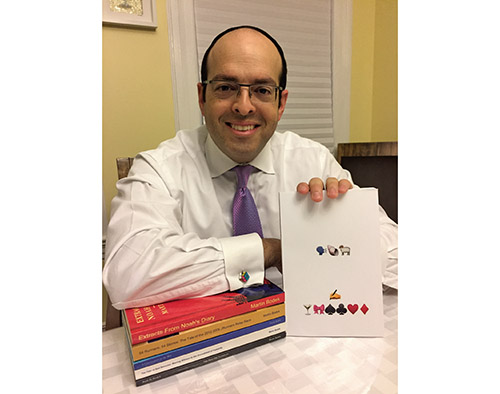


It may be just after Chanukah as you read these words, but get ready to think about Pesach for a few minutes with the publication of a Haggadah written completely in emoji symbols. As unbelievable as it seems, the entire volume is written out using only the 2,823 emojis in the Unicode Standard, with not a single letter of either Hebrew or English appearing anywhere in its 128 pages.
The emoji Haggadah is the brainchild of Passaic resident Martin Bodek and, to bring yet another Jewish holiday into the mix, came about as an offshoot of the family’s 2017 Purim theme. With all five Bodeks dressed in emoji wear, the 43-year-old father of three included an abridged version of the Purim story written entirely in emoji to match the family’s emoji-centric mishloach manot. The results were so well received that Bodek, who always enjoys a good challenge, decided to take things one step further, settling on the Haggadah as his next project.
It took Bodek nearly two years to finish what is undoubtedly the world’s first emoji Haggadah, spending time every night on the effort. The results are eye-opening, to say the least, and having perused the Haggadah’s pages, I highly recommend investing some time deciphering the text before attempting to actually use this at the Seder table. The cover alone gives a taste of what is to come, with emojis of a speaking man, a sea shell and a ram representing the words “Haggadah Shel Pesach” and emojis of a hand holding a pen, a martini, a bow and the symbols for all four suits in the standard deck of 52 playing cards portraying the words “written by Martin Bodek.”
Bodek found certain concepts and words relatively easy to translate into emoji. Pouring the second cup of wine before reciting Ma Nishtana appears as emojis of a faucet with a cup, a medal representing the number two and a glass of wine. Borrowing a page from Sefaria, the online Jewish library, Bodek used Sesame Street’s Count Von Count to depict Sefiras Haomer, but others were considerably more difficult.
“There are no emojis for the words ‘of,’ ‘the’ and ‘only,’” Bodek told The Jewish Link. “And the word ‘forever’ is used many times in the Haggadah but only appeared in a later update of the emoji set. It wasn’t there when I started the project so I used the number four and an evergreen.”
In other places Bodek utilized poetic license when he encountered words that had no emoji equivalents: a sweet-faced old lady represents the word “kindness” and rabbis appear as rabbits. His favorite substitution came about while trying to translate the name of one of the rabbinical figures in the Haggadah, with Bodek hoping that readers will be able to figure out that a rabbit plus a gaming console, the flag of Mali and an elf equals Raban Gamliel.
The emoji set was actually updated twice during the time that Bodek was working on the Haggadah and each time he revisited his earlier pages, working in the new symbols wherever appropriate. And while some might consider an emoji Haggadah somewhat unconventional, Bodek found it perfectly in keeping with the spirit of the holiday.
“Pesach rituals are all about keeping the kids interested and I feel that this adds to that,” said Bodek.
Bodek is the veteran of 35 marathons, including 20 New York City Marathons, and the words “giving up” simply aren’t part of his vocabulary, giving him the fortitude to persevere even when the going got tough. Ironically, Bodek said that the self-doubt that he has sometimes experienced when running a major race never reared its ugly head while penning his Haggadah. He has already authored five other books, and even as a child knew he wanted to become an author.
“Some kids dream of being astronauts, firemen or police officers, but I wrote my first book at six years old,” said Bodek. “I took a notebook and filled up every page with words and said, ‘I wrote a book and I am going to be a writer one day.’”
Bodek understands completely that the emoji Haggadah may be more than a little unconventional.
“People tell me ‘I don’t read emoji,” but they are wrong,” said Bodek. “As humans, we started out reading scratches on walls, and letters are just abstract representations of pictures. By reading emoji, we are coming full circle to our caveman days.”
The emoji Haggadah is currently available on Lulu.com and is expected to be on both Amazon and the Barnes and Noble website fairly soon. Bodek plans to use the Haggadah at his Seder table on Pesach and hopes that others will embark on an adventure into the world of emoji, taking the time to figure out the translations with others.
“I have always wanted to have a book of mine on people’s shelves, but this is a book that comes off the shelf and makes its way onto the table,” said Bodek. “Other books you sit down and read but this is something to be shared, which is very exciting.”
By Sandy Eller
Sandy Eller is a freelance writer who writes for numerous websites, newspapers, magazines and many private clients. She can be contacted at sandyeller1@gmail.com.









